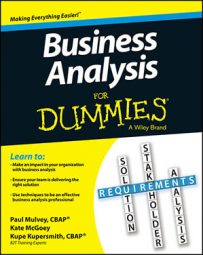The key to finding the right tool for your business analysis is identifying the kind of support or productivity boost that would be right for you by inventorying the situation you have now and determining what situation you need or want to have later, while being sure to avoid unnecessary tools. You also need to consider team size and budgetary constraints.
Review product offerings and functionality against your true needs very carefully. Consider specifically what you need to speed your definition work, and match your wish list of features to the product options accordingly.
Always make sure you get to know a tool and its feature set or benefits before you purchase or deploy it. If possible, try out or pilot test a tool first to accomplish a real-world business need.
No matter how fantastic a collaboration or analysis tool may be, what’s ultimately useful must line up against what you need to do with it. Just remember: No tool — no matter how slick and cool — magically solves all your problems.
Depending on what tools you pick in the end, you may need to get approval before deploying them, so keep that on your radar. For example, if the tool you want to use is fairly simple and economical (like index cards or sticky notes), chances are you don’t need to go through a whole approval process.
However, if the tool requires a significant outlay of cash and/or resources, you need to make sure you’re cleared for the expense. To get approval, just follow the general business analysis process: Identify your needs and requirements, define solutions, and present your case to whoever has approval power.
Review the current characteristics of your team, along with the productivity challenges you’re having, and write down the following:
What big-picture items (goals or end-products) you’re communicating or collaborating on
What you’re collaborating about (topics, information, or areas) within those items
Who’s adding to the collaboration (specific people)
What your team members are contributing (words and information, pictures or drawings, physical objects, and so on)
What the team members are doing with the contributions of others (assessing, enhancing, planning, managing, constructing, and so on)
Where the team members collaborate (physical location and typical atmosphere/environment)
At what time(s) of the day and for how long each individual is active in contributing toward the goal
What business analysis-related challenge you’re experiencing (or expect to be experiencing) and what change or improvement would help facilitate or increase your (or your team’s) productivity

